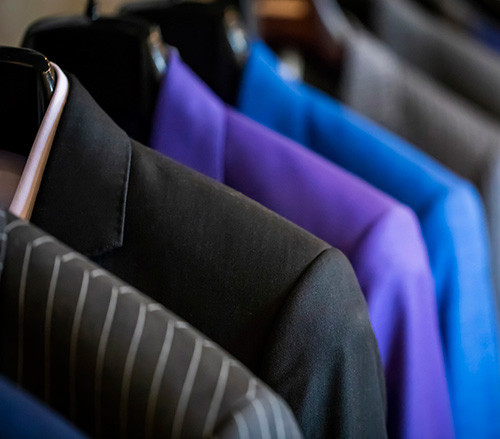
Applications
Fuju has a number of doctors and masters, focusing on product applications in each field, and providing solutions for many customers
The finishing to improve the performance of silk fabrics mainly include anti-wrinkle, anti-static, water and oil repellent, flame retardant, dimensional stability, washable and wearable. Finishing can not only eliminate the shortcomings of silk, but also improve other aspects of performance.
The wash and wear performance of silk fabrics has become increasingly important, and appropriate softeners, elastomers and synthetic resins must be used to meet the requirements. Finishing can make silk fabrics functional. The focus of silk fabric finishing is currently focused on anti-fouling and flame retardancy. Another important finishing area is to maintain sanitary and fresh antibacterial finishing. According to needs, the finishing process of silk fabric involves many processes. The selection of the finishing process must take into account the required silk feel and drape. The correct combination of finishing equipment and the order of finishing processes are the key to determining the final style of silk fabrics.
1. antistatic finishing
Silk can be grafted with monomer to improve the static electricity accumulation performance, so that the amount of static electricity accumulated on the silk fabric is appropriate. The higher the amount of styrene, the more static charge on the silk grafted with styrene. Antistatic agents are mainly divided into the following two types.
The function of static eliminator is mainly to improve the moisture absorption of fabric. Finishing silk fabrics with specific water-soluble vinyl monomers and specific acids can produce static elimination effects. Moreover, the electrical conductivity can be improved by depositing specific metal particles on the fabric. With metallic silver coating, hindering the electrical conductivity of silk fibers can also produce static elimination.
The principle of antistatic agent is to impart antistatic properties to the fabric by reducing the friction between fibers and between fibers and metals, which is mainly the result of lubrication. Generally, specific alkaline lubricants such as metal oil and butyl stearate are used as antistatic agents.
2. Waterproof and oil repellent finishing
Waterproof and oil repellent finishing can give the fabric water and oil repellency, while also having stain resistance, and does not affect the feel of the fabric.
The ideal waterproofing agent should have as little impact as possible on the air permeability, does not change the wet staining of the fabric, is compatible with other finishing agents, is easy to apply to the fabric, and imparts water-resistant performance to washing and dry cleaning.
The principle of waterproof and oil-repellent finishing is to reduce the surface energy of the fabric in the air so as to block oil or oily stains.
Teflon coating agent is the more commonly used fabric oil repellent surface finishing agent. Other important water repellents are: (1) Aluminum compounds used alone or together with soap; (2) Wax dispersants; (3) Wax dispersants containing aluminum salts; (4) Waxes containing zirconium salts Dispersant; (5) pyridine compound; (6) waxy thermal hardening inhibitor; (7) organosilicon; (8) fluorine compound.
When natural silk is grafted with steam of hexafluoropropylene, vinyl fluoride, vinyl chloride and acrylonitrile, its water resistance, oil repellency, mineral acid resistance and light stability will all be improved. These finishing agents can be rolled-baked-baked. Or the dipping method can process the silk fabric.
3. flame retardant finishing
Silk is self-extinguishing, and their "Limiting Oxygen Index" (LOI) is about 24. However, since silk fabrics cannot safely pass the "vertical flame test", flame retardant finishing is still required.
The laws of Western countries clearly stipulate that children’s clothing, especially pajamas, must be flame-retardant.
The flame retardant finishing agent must meet the following requirements: add an appropriate amount (approximately 15-20%) to obtain satisfactory results; should be resistant to household washing; should not cause loss of fabric strength; should not affect the feel of the fabric; should not cause fabric color The change; should not affect the light fastness of the dye on the fabric; the breathability of the fabric should not be affected.
The self-extinguishing property of silk is imparted by the reaction products of polyhalogen acids with a cyclic core, such as chlorsaccharic acid and thiourea. Technicians have discovered through research that titanium hexachloride, titanium tetrachloride and zirconium chloride can also give fabrics good flame resistance. The flame retardancy of silk fabrics can also be improved by finishing with non-ionic complexes of zirconium, titanium or tungsten. Since these finishings are carried out under acidic conditions, they are consistent with the acid dyeing conditions of silk fabrics.
Specific phosphorus-containing compounds can also improve the flame retardancy of silk fabrics, and the wrinkle resistance and shrinkage properties are also improved. In the presence of zinc fluorocarbon, the above-mentioned composite has good flame retardancy, and the washing fastness can also be improved to a certain extent.
4. antibacterial finishing
Antibacterial finishing is a finishing method that gives fabrics special functions. The main purpose is to protect fabrics from bacteria and protect consumers from spreading pathogens and bacteria.
Because textiles can provide sufficient conditions for bacteria to multiply, they can use many ways to destroy fabrics. These bacteria are everywhere, including: fabric and non-textile surfaces, the human body and all the surfaces we touch.
Bacterial reproduction will have a negative impact on human life style: such as annoying odor, bacterial contamination, allergic reactions, diseases and infections and product degradation.
Antibacterial finishing can prevent the propagation of bacteria on the surface of the fabric, give the fabric sanitation and freshness, prevent the generation of odor, control the generation of bacterial dirt, improve the feel of most fabrics, and prevent skin irritation.
The antibacterial properties of silk fabrics can be improved by impregnating the following compounds: N-(2,2-dichloroethylene) salicylamide 0.01~0.25% solution; salicylic anilide; dodecyltrimethylamine chloride Wait.
Phenolic compounds are widely used because they have moderate activity and can be deposited on the surface of the fabric in the form of an emulsion to compound into a polymer film. Compared with unfinished fabrics, silk fabrics finished with antibacterial agents have better antibacterial properties. The antibacterial agent can be used to treat the fabric by rolling, dipping or spraying. The baking temperature is 130-135℃.
5. Lightfast finishing
The chemical sensitivity of silk to light has always been one of the biggest obstacles to the application of silk fabrics. The fabrics exposed to the sun will absorb ultraviolet rays. In the presence of oxygen and moisture, many free radiation reactions will occur, resulting in fiber brittleness, so it is necessary to finish the silk to prevent free radiation. In other words, use ultraviolet absorbers or light stabilizers to finish silk fabrics.
In the past, chemicals such as thiourea, amine thiocyanate, tannic acid and other chemicals were used as lightfast finishing agents for silk fabrics, but after the emergence of ultraviolet absorbers, the lightfastness finishing of silk fabrics has undergone a fundamental change in technology.
The main types of ultraviolet absorbers are: (1) 2-hydroxybenzophenone (industrial) derivatives; (2) phenyl ester and salicylate (Ⅲ and Ⅳ); (3) 2-(2-hydroxybenzene) )-Benzotriazole (II) derivatives; (4) cinnamic acid substituted derivatives (V); (5) p-aminobenzoic acid ester; (6) polymeric and polymerizable absorbents; ( 7) Stabilizers, complexes and other salts such as nickel chelate (VII).
The choice of the type and concentration of UV absorbers depends on the composition of the matrix, the thickness of the sample, the desired color and process conditions. The general concentration in use is 1%, and the concentration of finishing agent can be as low as 0.2% of silk weight. The fabric can be finished by dipping in acid dye or disperse dye bath.
The light stability of silk is very important, so the development of this finishing agent is given priority internationally.
- No previous article
-
 1. The mechanism of organosilicon defoamer: The ability of sraed morePrinciple, type and application of silicone defoamer
1. The mechanism of organosilicon defoamer: The ability of sraed morePrinciple, type and application of silicone defoamer -
 wool fiber under the humid and hot conditions, through the rraed moreThe purpose and mechanism of woolen sweater felting
wool fiber under the humid and hot conditions, through the rraed moreThe purpose and mechanism of woolen sweater felting -
 The popularity of popular colors in home textiles further inraed moreThe five leading trends of home textile fabrics
The popularity of popular colors in home textiles further inraed moreThe five leading trends of home textile fabrics -
 Shinchem SS 6175 and Shinchem SS 6186 can be used for non-irraed moreNon-iron finishing application scheme for shirts and suits
Shinchem SS 6175 and Shinchem SS 6186 can be used for non-irraed moreNon-iron finishing application scheme for shirts and suits
